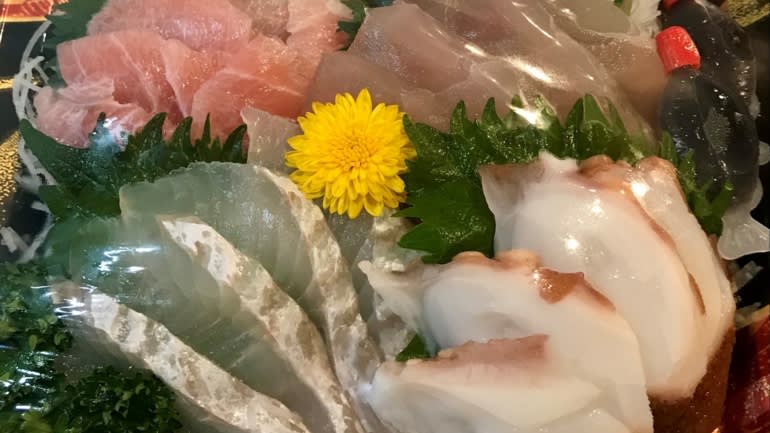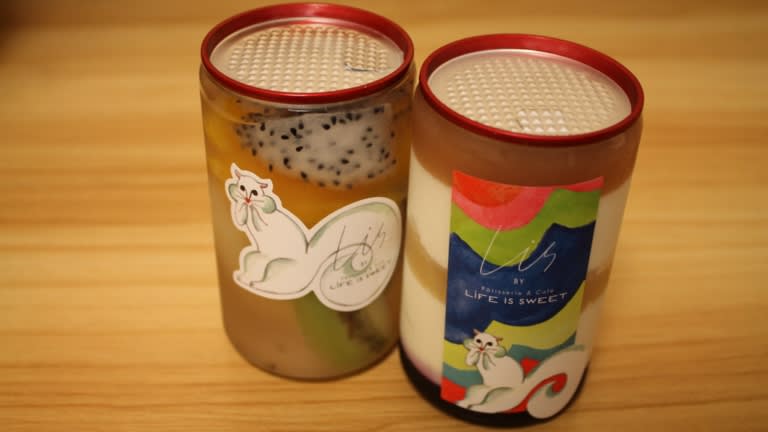KANAZAWA, Japan — A couple of brand-new vending machines selling sashimi, small pieces of fresh raw fish, recently made their debut in Kanazawa, Ishikawa Prefecture, on the Japan Sea coast. The food dispensers are the latest innovation in Japan’s rich vending machine culture.
The sashimi vending machines appeared in Ohmicho Ichiba, a market known as “Kanazawa’s kitchen,” earlier this month. The sashimi automats were set up primarily as a noncontact way to offer sashimi to customers during the COVID-19 pandemic. Now they are helping satisfy the late-night cravings of a whole new group of fish lovers.
The fresh-food automats are also a business opportunity for the companies that handle their installation and repair. They were set up by Ohguchi Suisan, a major fishmonger operating in the Ohmicho market, near a bus stop in the area. The machines offer sashimi sliced from fresh ocean-fresh fish landed in Ishikawa Prefecture and selected by professionals. Choices include octopus and deep-water shrimp. A variety pack containing three to four kinds of sashimi, selected daily, sells for 500 yen ($3.60).
You put in your money and out pops the sashimi, though sometimes upside down. Not to worry: The tightly wrapped sashimi remains firmly in place. The fish tastes good and, at 500 yen, seems like a bargain.
The vending machines are restocked with fresh sashimi twice a day, at around 9 a.m. and 3 p.m., and the products are growing in popularity. “They are sold out every day,” said Ohguchi Suisan director Masaru Araki.
The fish wholesaler put up the vending machines so that it could keep selling after its shop closes at 5 p.m., particularly to tourists staying in hotels in the neighborhood, as well as commuters on their way home from work, Araki explained. The self-service aspect also lowers labor costs — another advantage.
Ohguchi Suisan has three machines that offer not just sashimi but other types of fish as well, such as fried seasonal fish, fish pickled in saikyo-miso and a fish-over-rice-bowl topped with nodoguro (blackthroat sea perch), a local favorite. Two weeks after the machines were set up, “We are [still] finding out which items sell well,” Araki said, adding that the company will “brush up” its product line in the future.
The sashimi dispensers were set up by IRM Japan, a beverage vending machine installation and repair service based in Hakusan, Ishikawa Prefecture. “When we visit food companies, they often consult us about selling their products from vending machines these days,” said Hiroshi Watanabe, the company’s president. IRM became a sales agent for two manufacturers’ food vending machines last fall.
One of the company’s clients is Teraoka Chikusan, headquartered in Shikamachi, Ishikawa Prefecture, which runs a well-known steakhouse called Teraoka Fusha. The company set up a vending machine that sells steak and hamburger at its restaurant in Kanazawa in March last year.
The steak vending machine features an element of entertainment to attract buyers. Customers who purchase its 2,000 yen Steak Gacha have a 10% chance of winning 7,500 yen worth of Notogyu Premium beef. The machine takes in 400,000 to 500,000 yen per month, thanks to brisk sales at night. “After watching how things develop for a while, we will consider setting up steak vending machines on busy streets, or elsewhere in the city,” said Teraoka Chikusan Director Kazuhiko Teraoka.
One local bakery has also caught on to the trend. “We began selling sweets from a vending machine as the COVID-19 made it hard to sell face to face. But the machine is attracting unusual customers,” said Daiki Kawaguchi, owner of the Life Is Sweet cake shop in Kanazawa. Last October, the shop began offering cakes, puddings and compotes, among other items, from a vending machine, with the sweets packed in beverage can-shaped resin containers. The vending machine was converted from a drinks machine by IRM.
The cake shop’s unexpected customers are men who come alone. “They may have found it embarrassing to enter a cake shop before,” said Kawaguchi. These men typically buy a number of sweets at night. They probably bring back the sweets home for their families, he said.
The machine sell 30 to 40 items a day, on average, priced around 700 yen apiece. “We also want to set up vending machines in tourist spots,” Kawaguchi said.
Kanazawa citizens are particular about their food. The 2019-2021 Family Income and Expenditure Survey by the Ministry of Internal Affairs and Communications showed that average household spending on fresh fish and cake in Kanazawa was the highest among 52 big cities in Japan.
Kanazawa residents’ spending on beef was near the middle of the pack, at 26th, but their expenditures at beef barbecue restaurants was the third highest. If high-quality foods can be offered through vending machines in Kanazawa, people around Japan may be pulling more fresh food items from a slot on the corner.




